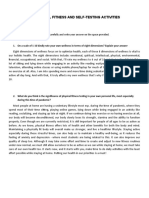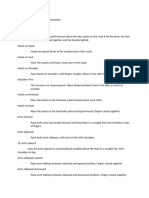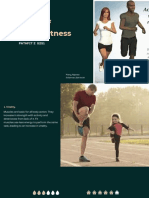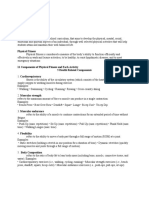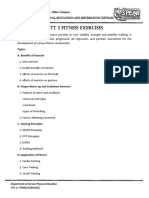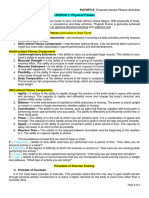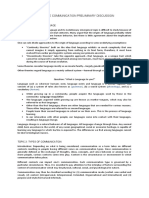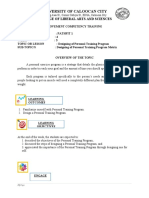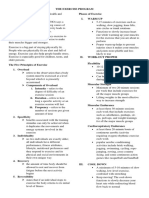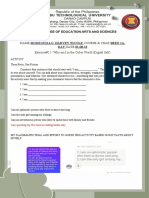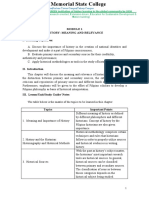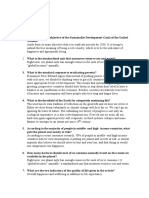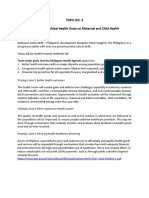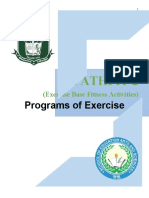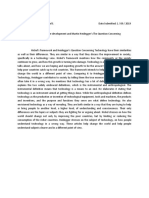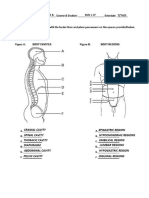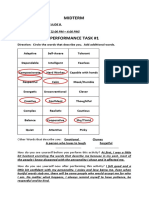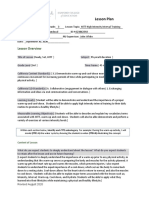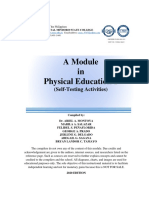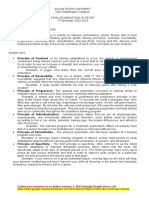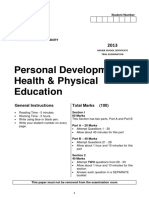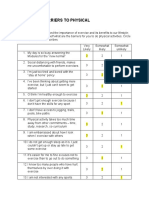1
PATHFIT 2
(Exercise Base Fitness Activities)
Planning a Personal Fitness
Program
1
� 2
Program Content
The most important part of planning a lifetime of fitness is planning a personal fitness program. This topic presentation
provides the basic steps necessary to plan such a personal exercise program.
Objectives
1. To define and discuss the importance of F.I.T.
2. To discuss the various components of exercise.
3. To discuss ways how to begin an personal fitness program.
4. To present tips on how to succeed in an exercise program.
Key Terms
1. F.l.T.: stands for Frequency (how often), Intensity (how hard) and Time (how long).
2. Aerobic Exercise: are exercise that increases the health and function of your heart, lungs, and circulatory
system.
3. Strength Training: is the process of exercising with progressively heavier resistance to build or retain muscle.
4. Flexibility: is a critical element of an exercise program but it is often overlooked. A good example is stretching.
Review Questions:
1. Why planning a personal fitness program important?
2
� 3
2. Why do we need to choose properly our exercise?
3. What are the steps we need to know on how to start our exercise program?
4. What are some of the tips we need to know to achieve success in our exercise program?
Planning a Personal Fitness Program
If you're planning putting a personal exercise program together it's perfectly normal to have a lot of questions swimming
around in your head. What's the best activity to participate in? How do I get the most out of exercising? How long should
I exercise?
Often, the hardest part of getting into shape is taking the first step. Here are some simple tips to help you begin your
fitness journey.
Think F.I.T.
To make physical improvements, you need to work your body harder than usual. This is referred to as the overload
principle. As your body becomes more conditioned, you need to increase the frequency, intensity, or time of your
workouts in order to continue improving your fitness level.
Frequency: How often you exercise. For beginners, consider starting with 2-3 sessions per week.
Intensity: How hard you exercise. For example, the pace you walk or run, the amount of weight you lift, or your
heart rate count.
Time: How long you perform an activity. "Time" can also refer to the number of sets or repetitions you perform in
weight training.
3
� 4
Exercise Component 1: Aerobic Exercise
Aerobic exercise increases the health and function of your heart, lungs, and circulatory system. For maximum
effectiveness, aerobic exercise needs to be rhythmic, continuous and involve the large muscle groups (primarily located in
the lower part of your body.) Walking, jogging, cycling, aerobic dance, and stair climbing are examples of activities that
use large muscle groups. Activities combining upper and lower body movements such as cross-country skiing, rowing,
and swimming can lead to even higher levels of aerobic capacity.
Exercise Component 2: Strength Training
Strength training is the process of exercising with progressively heavier resistance to build or retain muscle. Unless you
perform regular strength exercise, you will lose up to one-half pound of muscle every year of life after age 25. Muscle is
a very active tissue with high energy requirements, even when you are asleep, your muscles are responsible for over
25% of your calorie use. An increase in muscle tissue causes a corresponding increase in the number of calories your
body will burn, even at rest.
Exercise Component 3: Flexibility
Flexibility is a critical element of an exercise program but it is often overlooked. Stretching is important for a number of
reasons; increases physical performance, decreases risk of injury, increases blood supply and nutrients to the joints,
increases neuromuscular coordination, reduces soreness, improves balance, decreases risk of low back pain, and
reduces stress in muscles.
Choosing an Exercise
The best exercise is an activity that you enjoy enough to really pursue enthusiastically. Experiment with different forms of
activity (cross training). Alternating new activities with old favorites will keep your enthusiasm high. Cross training also
helps avoid injury due to repeatedly doing the same activity. Here are some suggestions:
4
� 5
Indoor (Facility) Activities: If the treadmill, stair master, rowing machine or stationery cycle doesn't excite you,
sample some group activities that strike your fancy. Participate in a group cycling class, beat stress with yoga,
find balance with martial arts, stay cool with indoor swimming, or kick some you-know-what with box aerobics.
At Home Activities: You don't need to join a gym to experience a variety of activities. Your local video store or
library will carry a variety of fitness videos that allow you to work out in the privacy of your home. Some
equipment may be required, depending on the activity you select. A few inexpensive pieces of equipment include
a jump rope, a set of hand weights (preferably with weight plates that you can add and remove), Dyna-Bands or
tubing, or a basic step (for step aerobics).
If you enjoy working out at home then you may want to consider investing in a larger piece of equipment such as
a treadmill, stationery bicycle, or elliptical trainer.
Outdoor Activities: Outdoor activities abound during all four seasons. Sample the variety of activities available to
you. For example, take a hike to enjoy the fall colors, learn to cross-country ski when Old Man Winter visits,
walk among the flowers in the spring, or dive into swimming during the hot months of summer. Getting outdoors
into the fresh air not only adds variety to your exercise program but it seems to provide an uplifting of one's spirit
as well.
Determining Your Starting Point
To achieve cardiovascular benefits, the American College of Sports Medicine (ACSM) recommends exercising 3-5 times
per week (frequency) with a training heart rate of 60-85 percent of your maximum (intensity) for 20-60 minutes (time).
To attain muscular fitness benefits, the ACSM recommends weight training two days per week (frequency), performing
one to three sets of 10 repetitions (time) of eight to ten different exercises at approximately 70-85 percent of your one
repetition maximum (intensity.) If you're just beginning an exercise program, start in the low range of the above
recommendations. For example, participate in a cardiovascular activity (walking, aerobics, cycling, etc.) for 20 minutes,
three times a week and add strength training exercises to your workout, twice a week. Schedule your strength training
workouts with 48 hours rest in between to allow your muscles to recuperate and repair after each workout.
Begin Slowly and Gradually Build
5
� 6
Unfamiliarity with movements and equipment can prove frustrating enough that you may consider throwing in the towel.
Take heart, it's normal to feel awkward in the beginning, especially if you have undertaken an activity that you aren't
familiar with. It doesn't take long for your skill to improve if you stick with it. After all, even fitness instructors were once
beginners!
If you attempt "too much, too soon" it will lead to soreness, fatigue and/or injuries. Work at your own level, start out
slow, and gradually increase duration and level of difficulty as your body progresses. Getting fit is not an overnight
proposition, it's a lifestyle commitment. Don't expect immediate dramatic changes in your body shape or weight loss.
Although changes are happening internally, most external benefits won't become visible for the first four to six weeks.
Stay focused on your lifestyle choice and celebrate the internal benefits you're experiencing such as increased energy,
less stress and anxiety, higher self-esteem, and an increased feeling of well-being.
Staying Motivated
Only one-third of those who begin an exercise program are still exercising by the end of their first year. The good news
is that with some strategizing and planning, you can beat the dropout odds and make a successful transition to a lifestyle
that incorporates exercise. Here's some tips to help you stay motivated.
Find a Fitness Partner: Studies show that exercise adherence is generally greater if the family or a friend is
included in the commitment to exercise. Find a walking partner, play tennis with your spouse, or go rollerblading
with the kids.
Start an Exercise Log or Journal: An exercise log or journal is an excellent way to chart your progress and
provide motivation. Nothing beats the feeling of success as you read through your accomplishments. Exercise
logs can take on many forms; a calendar to record your workouts, a daily journal to record your feelings and
goals, a computerized exercise log, or a log purchased at bookstore. The key is to select a log or journal that
fits your needs and provides you the kind of information that is meaningful to you.
Schedule Your Workouts: Exercise must be a priority in order to establish it as a lifestyle practice. Make time
for your workouts and schedule them on your daily calendar or planner.
Toss Your Scale: Ask yourself, "How often has stepping on the scale in the morning ruined my day?" If your
answer is "often," consider whether or not you should give that little machine such power over you. The fact is
6
� 7
that exercise should not revolve around a number on a scale. Exercise should be about making a commitment to
your health and well-being, and weight loss is a natural side effect of that commitment.
Dress the Part: Wear comfortable clothes appropriate for exercising, they will help you feel like working out. If
you exercise at a gym put your exercise wear in a bag and set it beside the door the night before. When it's
time to head out the door, all you have to do is grab your bag on the way out.
Entertain Yourself: If you exercise alone, consider using a portable music device to listen to your favorite music
or books on tape to help keep you entertained during your workout. Many pieces of exercise equipment have
racks that fit onto the console to hold reading material. If you exercise at home, turn on some music or bring the
television within viewing range.
Evaluate Your Progress: It's a good idea to test your fitness level when you start and re-evaluate yourself every
couple of months. There are a variety of fitness tests that you can administer yourself. Getting a body
composition test is another great way to chart your progress and can be done every four to six months. The local
YMCA or fitness club can perform this test at a minimal cost, even if you're not a member.
Make Exercise Non-Negotiable: Think of exercise as something you do without question, like brushing your
teeth or going to work. Taking the lifestyle perspective will help you make exercise a habit.
Tips for Exercise Success
Swimming, cycling, jogging, aerobic dancing, walking or any of dozens of other activities can help your heart. They all
cause you to feel warm, perspire and breathe heavily without being out of breath and without feeling any burning
sensation in your muscles. Whether it is a structured exercise program or just part of your daily routine, all exercise
adds up to a healthier heart.
Here are some tips for exercise success:
If you've been sedentary for a long time, are overweight, have a high risk of coronary heart disease or some
other chronic health problem, see your doctor for a medical evaluation before beginning a physical activity
program.
Choose activities that are fun, not exhausting. Add variety. Develop a repertoire of several activities that you
can enjoy. That way, exercise will never seem boring or routine.
7
� 8
Wear comfortable, properly fitted footwear and comfortable, loose-fitting clothing appropriate for the weather and
the activity.
Find a convenient time and place to do activities. Try to make it a habit, but be flexible. If you miss an exercise
opportunity, work activity into your day another way.
Use music to keep you entertained.
Surround yourself with supportive people. Decide what kind of support you need. Do you want them to remind
you to exercise? Ask about your progress? Participate with you regularly or occasionally? Allow you time to
exercise by yourself? Go with you to a special
Event, such as a 10K walk/run? Be understanding when you get up early to exercise? Spend time with the
children while you exercise? Try not to ask you to change your exercise routine? Share your activity time with
others. Make a date with a family member, friend or co-worker. Be an active role model for your children.
Don't overdo it. Do low- to moderate-level activities, especially at first. You can slowly increase the duration
and intensity of your activities as you become more fit. Over time, work up to exercising on most days of the
week for 30-60 minutes.
Keep a record of your activities. Reward yourself at special milestones. Nothing motivates like success!
A Beginner's Guide
Proceed with caution. Anyone beginning an exercise regimen should begin slowly. Allow yourself to get used to the strain
of physical activity. As your body adjusts, you'll be able to increase the duration and intensity of your program. If you feel
any discomfort, stop exercising and consult your doctor.
Dress comfortably in loose-fitting clothing. Wear the appropriate footwear. Consider the weather. If the temperature and
humidity are extreme, either too high or too low, physical exertion may be dangerous.
Begin with a "warm-up" session. Stretch muscles slowly to avoid injury during the actual exercise. Get your respiration,
circulation, and body temperature to increase by beginning with some low-impact exercises. Your warm-up should last
about three to five minutes.
Begin the actual exercise phase at a moderate intensity. The duration will build cardiovascular fitness. Don't overexert
yourself. If you exercise regularly, you'll be able to lengthen the time and increase the intensity. While you're exercising,
you should feel your heart beating faster. You should be breathing more rapidly and deeply, yet still be able to carry on a
conversation. You should begin to sweat. These are ways that your system responds to the challenges of exercise.
8
� 9
End with a "cool down" session. Spend a few minutes walking slowly to let your body gradually decrease itself. Just as
you needed to gradually begin to exercise, you need to gradually begin to rest.
Plan for your next exercise session. Commit to it. In order for exercise to be truly effective, it must become a regular part
of your routine. Cardiovascular fitness needs to be maintained.
